Contents
Deployment Overview
This document describes how to set up multi-factor authentication (MFA) for VMware Unified Access Gateway (UAG) with AuthPoint as an identity provider. VMware Unified Access Gateway must already be configured and deployed before you set up MFA with AuthPoint.
VMware Unified Access Gateway can be configured to support MFA in several modes. For this integration, we set up SAML with AuthPoint.
VMware Unified Access Gateway is a part of VMware Horizon 8. For SAML authentication to function, VMware Unified Access Gateway needs the services of VMware Horizon 8. In this document, VMware Horizon 8 employs VMware Connection Server for VMware UAG SAML authentication. SAML configuration is done both in VMware UAG and the VMware Horizon Connection Server.
Integration Summary
The hardware and software used in this guide include:
- VMware Horizon 8
- VMware Unified Access Gateway 22.12.0
- VMware Horizon Connection Server 8.8.0
- VMware vCenter Servers 7.0.0
- VMware Horizon Agent 8.8.0
- VMware Horizon Client 8.8.1
- AD DS, AD CS, and DNS on Windows Server 2019
- WatchGuard Cloud
VMware Unified Access Gateway SAML Authentication Data Flow with AuthPoint
AuthPoint communicates with various cloud-based services and service providers with the SAML protocol. This diagram shows the data flow of an MFA transaction for a VMware Unified Access Gateway.
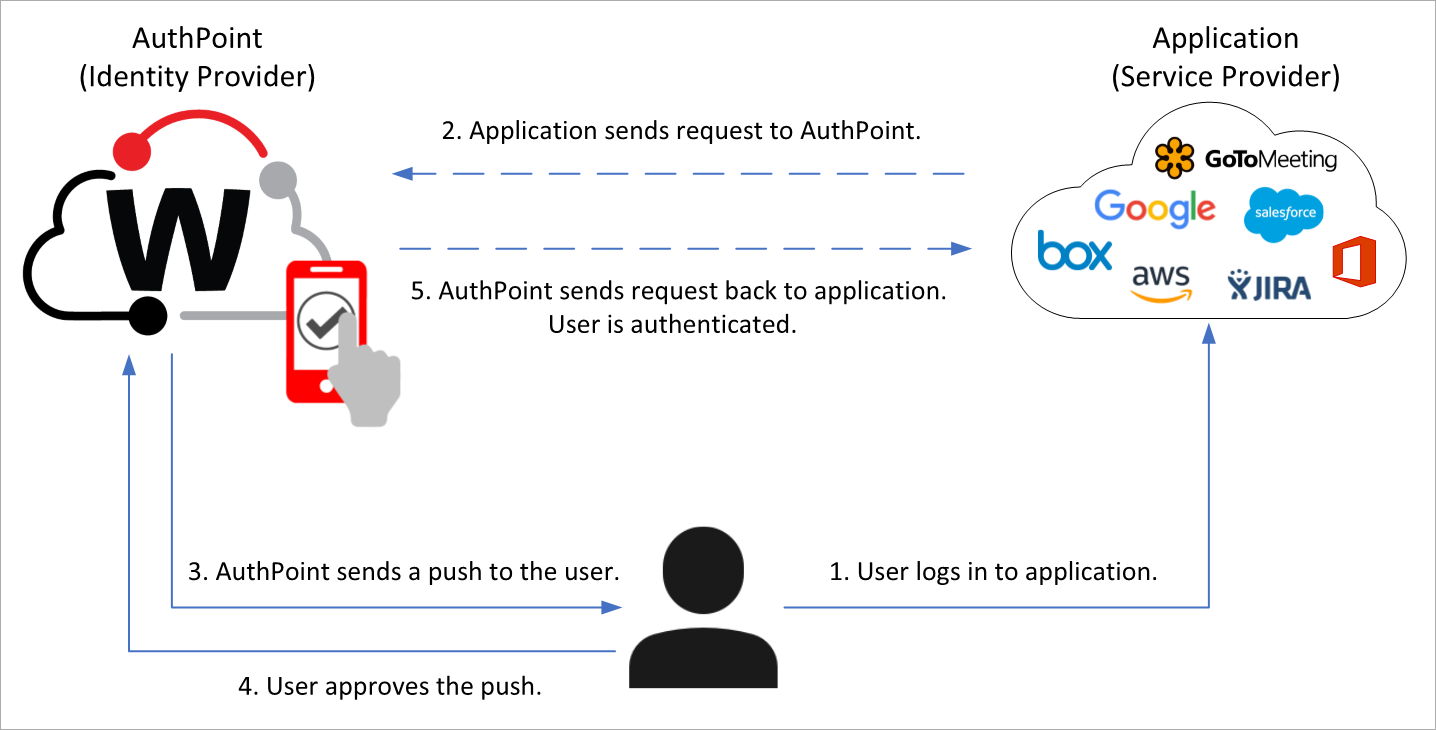
Before You Begin
Before you begin these procedures, make sure that:
- Unified Access Gateway is connected to Horizon Connection Server
- Horizon Connection Server is connected to vCenter Server
- vCenter Server manages a Virtual Machine that has Horizon Agent installed
- Horizon Connection Server has published one or more apps that exist on the Virtual Machine with Horizon Agent installed
- You can use Horizon Client to log in to Connection Server and invoke published app(s) with a user that exists in the Active Directory domain
- A token is assigned to a user in AuthPoint
- You have an AuthPoint identity provider (IdP) certificate (go to Certificate Management)
Configure Unified Access Gateway
To start, you must download the metadata file and the certificate file from the Certificate Management page in the AuthPoint management UI. After you have those, you can configure Unified Access Gateway.
From the WatchGuard Cloud web UI:
- From the navigation menu, select Configure > AuthPoint. If you have a Service Provider account, you must select an account from Account Manager.
- Select Resources.
- Click Certificate.

- Next to AuthPoint certificate, you will associate with your resource, click
 and select Download Metadata. We recommend that you choose the certificate with the latest expiration date. If you do not have a certificate, or if all of your certificates have expired, click Add Certificate and use the newly created certificate.
and select Download Metadata. We recommend that you choose the certificate with the latest expiration date. If you do not have a certificate, or if all of your certificates have expired, click Add Certificate and use the newly created certificate.The AuthPoint metadata provides your resource, in this case, Unified Access Gateway, with information necessary to identify AuthPoint as a trusted identity provider.
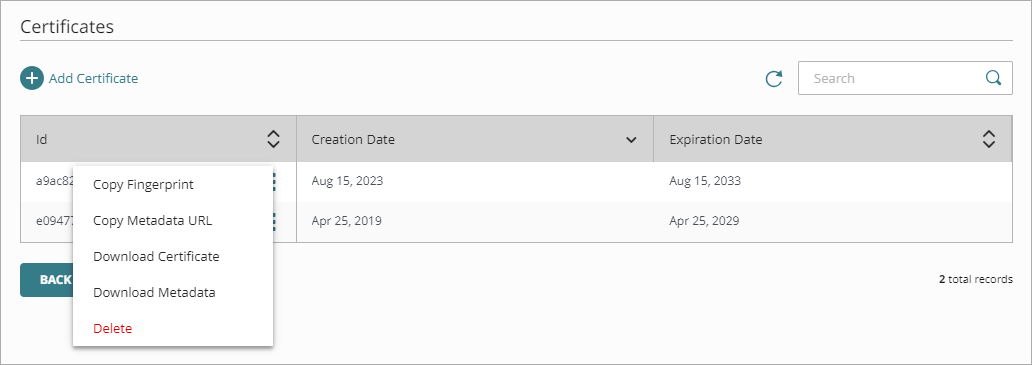
- Log in to the Unified Access Gateway admin interface as an admin.
- Under Configure Manually, click Select.
- In the Advanced Settings section, under Identity Bridging Settings, click
 next to Upload Identity Provider Metadata.
next to Upload Identity Provider Metadata.
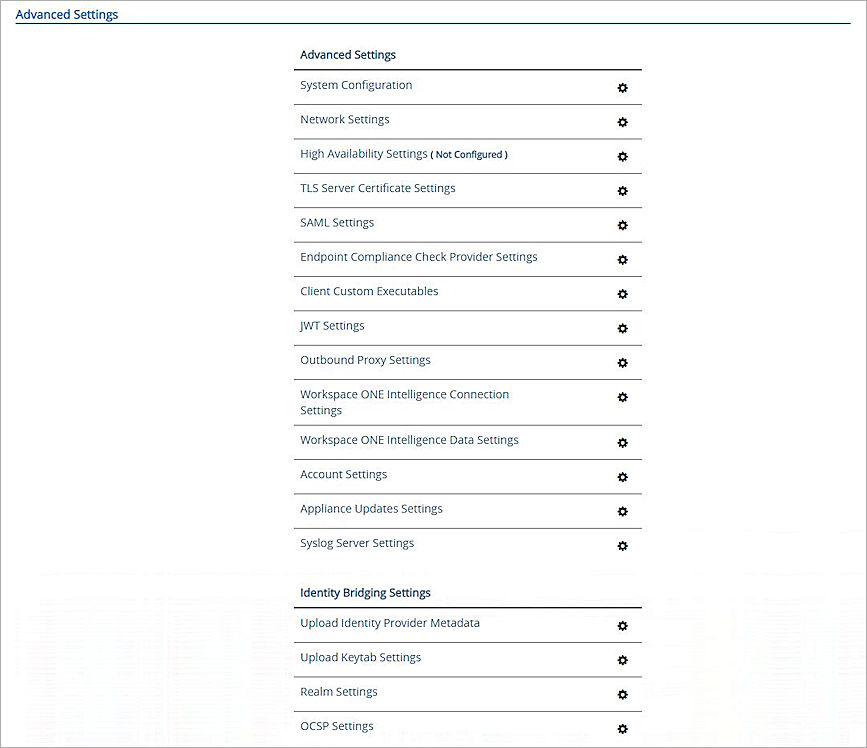
- In the Entity ID text box, type the entityID value from the AuthPoint metadata file.
- Next to IDP Metadata, click Select and upload the metadata file you downloaded from AuthPoint.
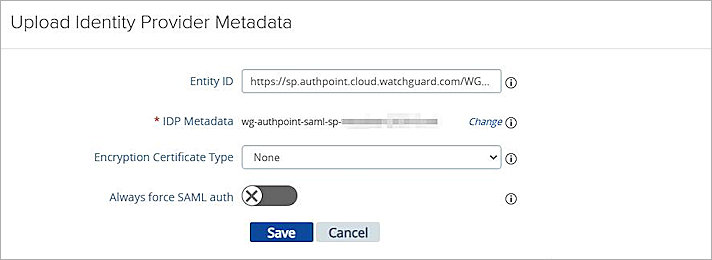
- Click Save.
- In the General Settings section, enable Edge Service Settings.
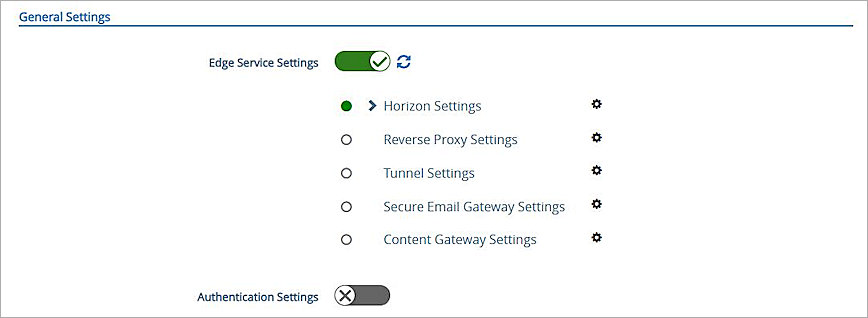
- Click the Horizon Settings gearbox icon.
- Click More.
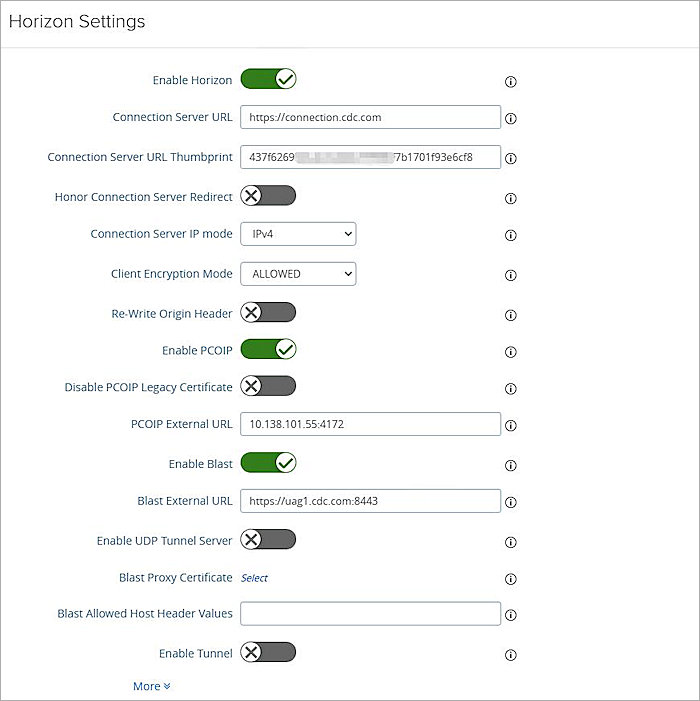
- From the Auth Methods drop-down list, select SAML.
- From the Identity Provider drop-down list, select the IDP you created.
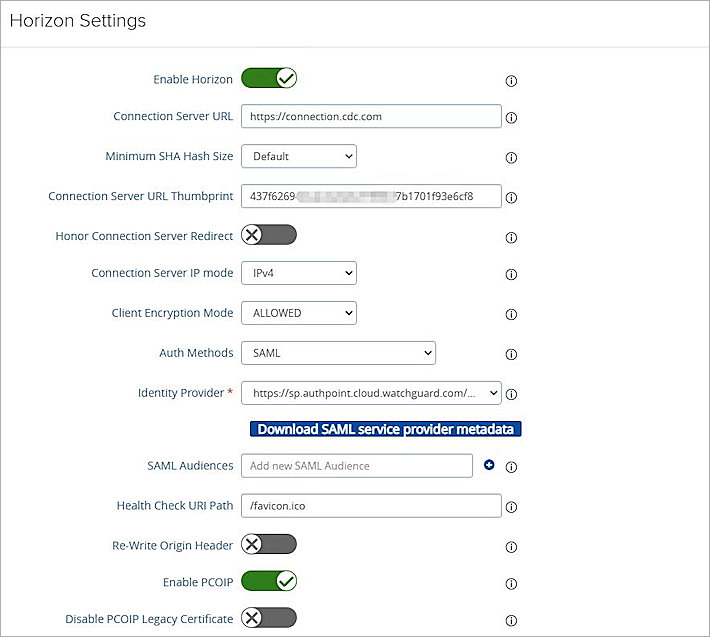
- Click Download SAML service provider metadata. You will use the information in this metadata file to configure a SAML resource in AuthPoint.
- In the External Host Name text box, type the host name that Horizon Client connects to.

- Click Download.
- Click Save.
Configure Connection Server
- Log in to the Horizon Console as an administrator.
- From the navigation menu, select Settings > Servers > Connection Servers.
- Select the existing connection server.
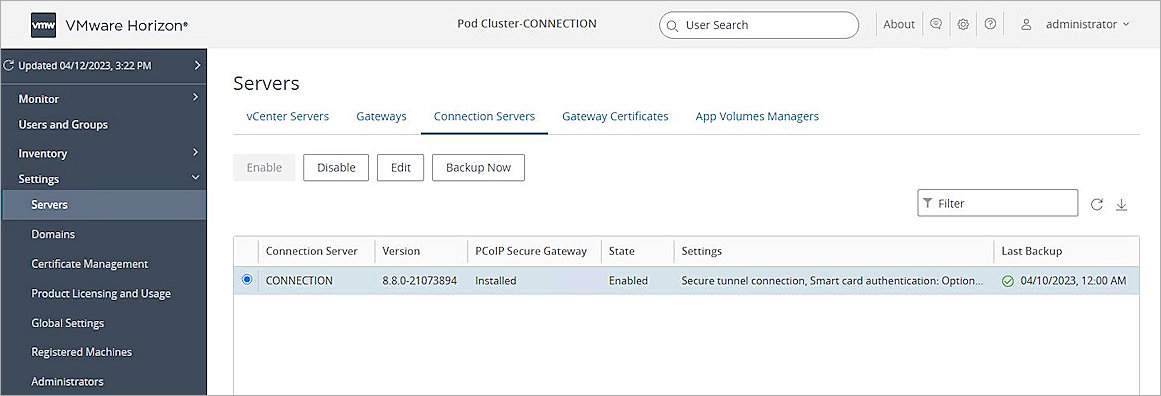
- Click Edit.
- Select the Authentication tab.
- From the Delegation of authentication to VMware Horizon (SAML 2.0 Authenticator) drop-down list, select Allowed.
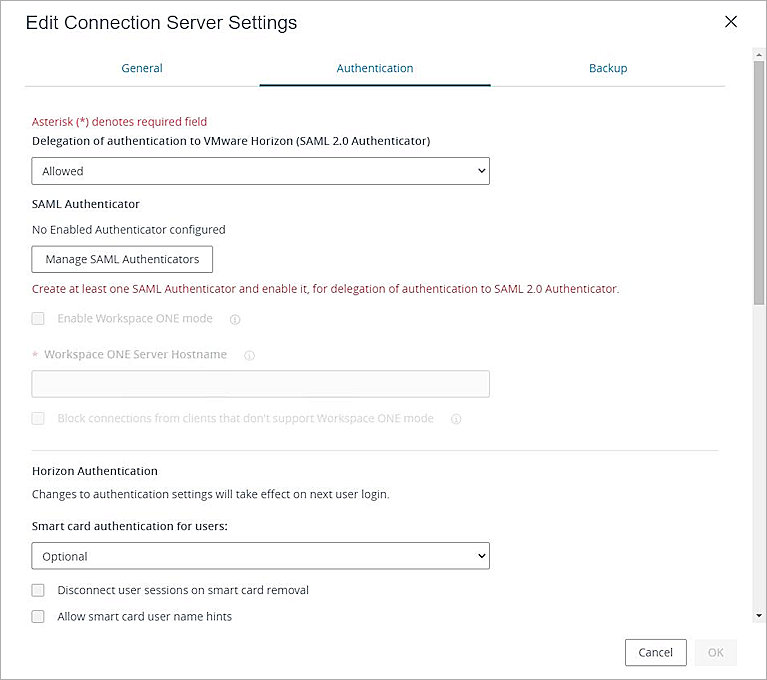
- Click Manage SAML Authenticators.
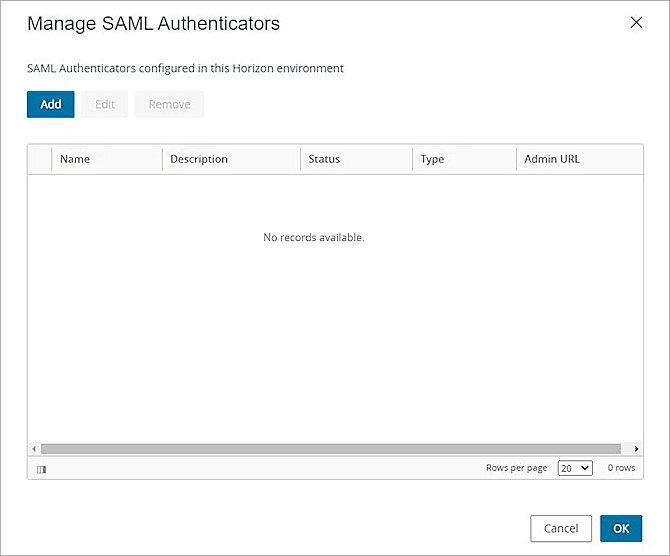
- Click Add.
- For Type, select Static.
- In the Label text box, type a name. In our example, we name the SAML authenticator AuthPoint.
- In the SAML Metadata text box, copy and paste the contents of the AuthPoint metadata file.
- Select the Enabled for Connection Server check box.
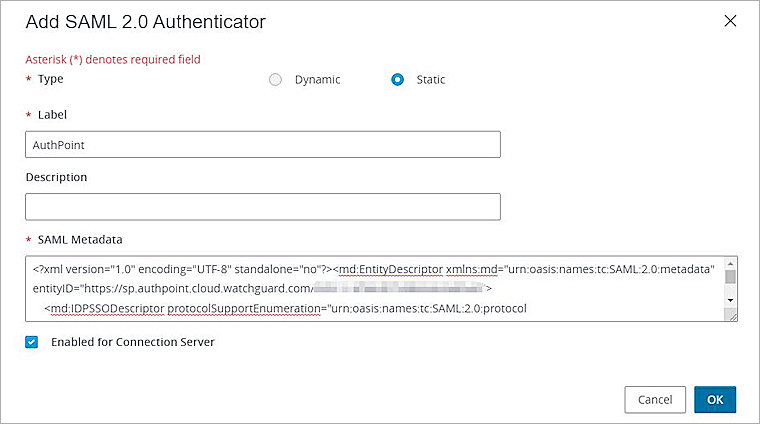
- Click OK.
- Click OK.
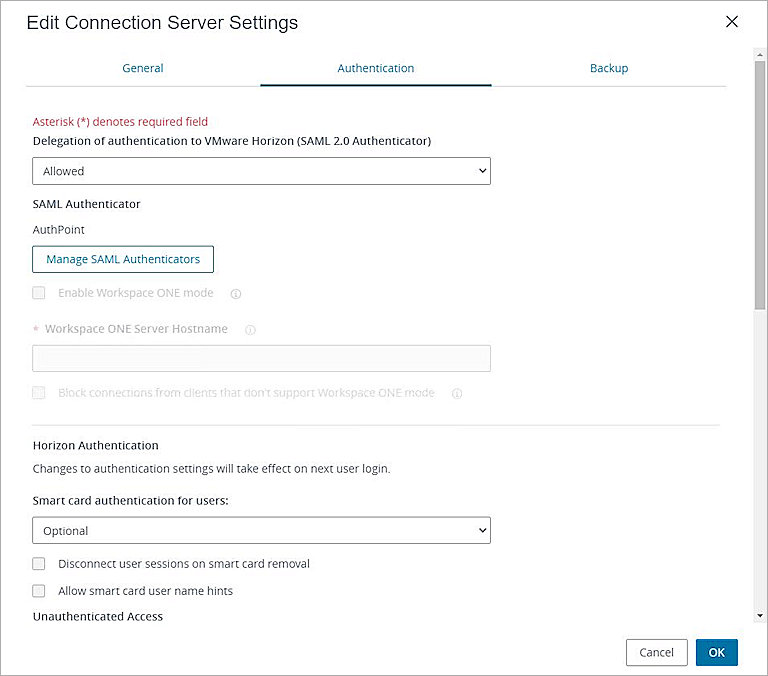
- Click OK.
Configure AuthPoint
Before AuthPoint can receive authentication requests from Unified Access Gateway, you must add a SAML resource in AuthPoint. You must also create a Zero Trust authentication policy for the Unified Access Gateway resource to determine which users can authenticate and log in to Unified Access Gateway and which authentication methods they can use (Push, QR code, and OTP).
Add a SAML Resource in AuthPoint
From the AuthPoint management UI:
- From the navigation menu, select Resources.
Click Add Resource.
The Add Resource page opens.

- From the Type drop-down list, select SAML.
Additional fields appear.

- Type a name for this resource.
- From the Application Type drop-down list, select Unified Access Gateway.
- Open the SAML service provider metadata file you downloaded in the previous section and copy the entityID and AssertionConsumerService Location values.
- In the Service Provider Entity ID text box, type or paste the entityID value from the SAML service provider metadata file.
- In the Assertion Consumer Service text box, type or paste the AssertionConsumerService Location value from the SAML service provider metadata file.
- From the User ID sent on redirection to service provider drop-down list, select User Name.
- From the Signature Method drop-down list, select SHA-256.
- From the AuthPoint Certificate drop-down list, select the certificate to associate with your resource. This must be the same certificate that you downloaded the metadata for in the previous section.
- Click Save.
Add a Group in AuthPoint
You must have at least one user group in AuthPoint to configure MFA. If you already have a group, you do not have to add another group.
To add a WatchGuard Cloud-hosted group to the WatchGuard Cloud Directory:
- Go to Configure > Directories and Domain Services.
- Click the WatchGuard Cloud Directory domain name. If you have not yet added the WatchGuard Cloud Directory, click Add Authentication Domain and select the WatchGuard Cloud Directory.
The New Group page appears.

- In the Groups tab, click Add Group.
- In the Group Name text box, type a descriptive name for the group.
- (Optional) In the Description text box, type a description of the group.

- Click Save.
Your group is added to the WatchGuard Cloud Directory and to AuthPoint.
Add a Zero Trust Authentication Policy
Zero Trust policies specify which resources users can authenticate to and which authentication methods they can use (Push, QR code, and OTP).
You must have at least one Zero Trust authentication policy that includes the Unified Access Gateway resource. If you already have Zero Trust authentication policies, you do not have to create a new authentication policy. You can add this resource to your existing authentication policies.
Users that do not have an authentication policy for a specific resource cannot authenticate to log in to that resource.
To configure a Zero Trust authentication policy:
- Go to Configure > Zero Trust. If you have a Service Provider account, you must select an account from Account Manager.
- Click Add Policy.
- Type a name for this policy.
- In the Target section, from the Content drop-down list, select which groups this policy applies to. You can make multiple selections to add multiple groups.
- In the Resources section, select the AuthPoint resources this policy applies to.
- In the Conditions section, select the conditions that apply to this policy. When you add a condition to an authentication policy, the policy applies only to user authentications that match the policy and the policy conditions. For example, if you add a Network Location to a policy, the policy only applies to user authentications that come from that Network Location. Users who only have a policy that includes a Network Location do not get access to the resource when they authenticate outside of that Network Location (because they do not have a policy that applies, not because authentication is denied). For more information, go to About Zero Trust Conditions.
- (Optional) To create a new condition, click Add New Condition. After you create a new condition, you must still add the condition to the policy.
- From the Type drop-down list, select the type of condition to add to the policy.
- From the Name drop-down list, select which condition of the chosen type to add to the policy.
- To add more conditions, repeat Step 6.
If you add conditions to a policy, we recommend that you create a second policy for the same groups and resources without the conditions. Assign a higher priority to the policy with the policy objects. For more information about priority, go to About Zero Trust Policy Precedence.
- In the Action section, select an option to specify whether to allow or deny authentications for the resources in this policy. In our example, we want to allow authentications.
- Allow — Allow user groups in this policy access to the resources associated with this policy.
- Deny — Deny authentications when users in the groups associated with this policy try to authenticate to the resources associated with this policy.
- If you allow access with this policy, select the check box for each authentication option users can select when they authenticate to resources in this policy with MFA.
For SAML resources, if you select more than one authentication option, users must select one of the available options when they authenticate. For example, if you select OTP and Push, users can choose to type their OTP or approve a push to authenticate. You cannot require that they do both.
- Click Save.
Your policy is created and added to the end of the policy list. - Review the order of your policies and adjust as necessary. For more information about priority, go to About Zero Trust Policy Precedence.
Sync Users to AuthPoint from Active Directory
You must create AuthPoint user accounts for your users. To sync users from Active Directory, you must add an LDAP external identity and create one or more queries.
In AuthPoint, LDAP external identities represent external user databases. They connect to user databases to get user account information and validate passwords. The queries you add to an external identity specify which users to sync from your Active Directory or LDAP database. They pull user information and create AuthPoint user accounts for the users that are found.
For detailed instructions to sync users from Active Directory, see Sync Users from Active Directory or LDAP.
Test the Integration
To test the integration of AuthPoint and the configuration of the Unified Access Gateway, you can authenticate with a mobile token on your mobile device. You can choose any method (one-time password, QR code, or push).
In this example, we show the push authentication method (users receive a push notification in the mobile app that they must approve to authenticate).
- Open VMware Horizon Client.
- Connect to Unified Access Gateway external FQDN. In our example, the FQDN is uag1.cdc.com.
VMware Horizon Client opens a browser. - Type your AuthPoint user name. Click Next.
- If required, in the Password text box, type your password.
- For the authentication method, select Send Push.
- Approve the authentication request that is sent to your mobile device.
You are logged in to VMware Connection Server, then you can invoke the published app.